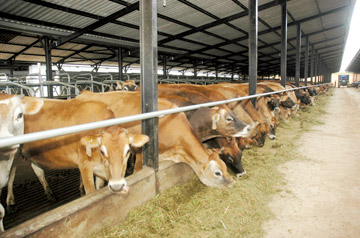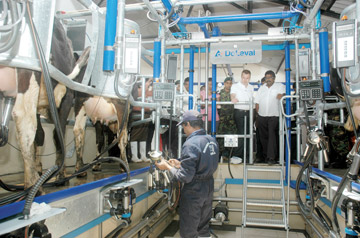|
Marked increase in milk production:
Imported cows will boost self-sufficiency
By P. Krishnaswamy

Imported cows at the Bopatalawa Farm |

Minister of Livestock and Rural Community Development Arumugan
Thondaman and other officials inspect the automated milking. |
 |
| The newly
constructed cattle shed where the imported cows are housed. |
With the addition of the 2000 hybrid cows imported from Australia the
National Livestock Development Board (NLDB) now has 12,000 cows in its
32 cattle farms in the country and the imported cows have considerably
contributed to the government’s target of achieving self-sufficiency in
milk and milk products by the year 2016, NLDB Chairman Ranjith Ellegala
told the Sunday Observer.
The imported cows are in the Bopatalawa, Diyagama and Menikpalama
farms. Prior to the import of the cows, the total milk production in the
NLDB farms was 8,000 litres per day whereas after the import of cows ,
the milk production at the Menikpalama farm alone reached 8,000 litres,
he said.
The cows were imported on President Mahinda Rajapaksa’s instructions
to the Minister of Livestock and Rural Community Development Arumugan
Thondaman to accelerate the program of achieving self-sufficiency in
milk and milk products, he said.
The allegations that the imported animals cannot adapt to the Sri
Lankan climatic conditions is totally incorrect and of the total 2000
animals imported only 7 died which is the accepted mortality rate in the
process of importing cattle.
The other animals are healthy and provide an average of 26 litres of
milk per day, Ellegala said. The first 500 cows were imported in August
2012 and the second batch of 1500 were imported in January 2013, he
said.
Each cow gives a minimum of 5 calves and it has been ensured under
the artificial sex semen insemination that 4 are females. So far 120
calves have been distributed among dairy farmers in the central hill
country which would help improve the genetic potential of the animals,
Ellegala said. The services of seven very senior veterinarians, better
infrastructure and automated milking parlours are other facilities that
have been introduced to the industry, he said.
Four of the 32 NLDB farms in the upcountry are the Bopatalawa,
Menikpalama, Diyagama and Rosita farms , two farms are in the deep south
in Weerawila and Biyagama and the other 24 farms are in the mid country
in the North-Western and North-Central Provinces, Ellegala said.
The plantation people engaged in small time dairy farming and farmers
in the other parts of the country can earn a minimum of Rs. 1000 per day
since the current payment for a litre of milk is Rs. 50, he said.
Speaking to the Sunday Observer, the Secretary to the Ministry of
Livestock and Rural Community Development Dr. K. M. T. Kendaragama said
the Cabinet, at its last sitting, approved a cabinet paper tabled by
Minister Thondaman for setting up another farm with 2500 high quality
cows and the project will be completed within this year.
All details of the project will be worked out and finalised within
the next three months, he said. The NLDB will obtain a loan to implement
the project, he said. The first batch of 500 cows imported in August
last year from Australia have multiplied after calving and the second
batch of 1500 will also start calving in about three months.
By June this year, the milk production from the three farms where the
cows are stocked will exceed 30,000 litres per day, Dr. Kendaragama
said. The quality of the milk from the imported animals is optimum and
so will be the milk from their calves that are being distributed among
farmers when they mature as milch cows. The milk will also fetch a
higher price for the farmers, he said.
The cost of an imported animal is between SL Rs. 285,000 to SL Rs.
300,000 and the reports in some sections of the media alleging that it
cost SL Rs. 800,000 is incorrect, he pointed out.
All modern technologies have been introduced in the maintenance,
feeding and milking of the cows( automated milking) in the farms and
also in the milk processing centres, Dr. Kendaragama said.
Fifty percent of the national requirement of milk and milk products
has already been reached and achieving self-sufficiency in 2016 will not
be a difficult task, he said. Sixteen milk chilling centres have already
been entrusted to the management of the farmers’ associations and the
other chilling centres too will be entrusted to the associations phased
over a period in the future so as to encourage farmers and boost
productivity, he said.
A chilling centre with the building costs approximately Rs.2 million
and only the management has been entrusted to the farmers’ societies and
not the ownership, Kendaragama said. The services of 13 veterinary
surgeons attached to MILCO will be available to the farmers’ societies
and the farmers, in addition to the services of the government
veterinary surgeons, he said.
A total of 230,000 farmers live in the country today including those
in the North and East. The MILCO is working on establishing collecting
centres in the North while a large number of collecting centres have
already been established in the Eastern Province with more to be
established in the future. Import tax on all equipment needed for
processing milk has been waived by the government and, consequently, a
large number of requests seeking approval for importing the equipments
has already been received by the Ministry, he said.
The favourable features introduced in the last budget, including the
imposition of an increased import tax on all milk products, will
strengthen the farmers and encourage them to compete with importers in
the market which, in turn, will facilitate achieving self-sufficiency in
milk and milk products in 2016.
The Ministry of Livestock and Rural Community Development has already
initiated several programs to boost milk production. Two years ago the
country was producing only 20 – 22 percent of the total requirement and
today we are producing more than 50 percent of the requirement,
Kendaragama said.
In the post-conflict period, people have the freedom to do what they
want to do. Many of them who were traditional dairy farmers have
returned to their profession. Batticaloa and Ampara regions have
recorded a rapid development in milk production, pushing many other
regions behind. Dairy farming has been started in Kilinochchi and other
terrorism-torn areas of the North.
The animals had been in the jungles and had to be brought back. The
country will save a staggering US $ 400 Million per year which could be
utilised for improving the dairy farming sector. Last year’s 84,000
tonnes of imported milk products cost the national coffers Rs. 30
billion, Kendaragama said. |



